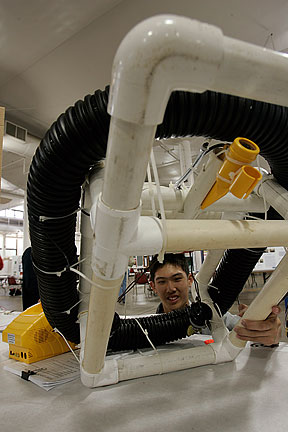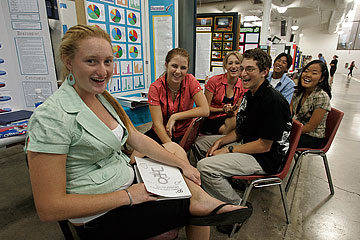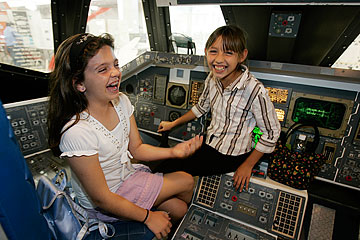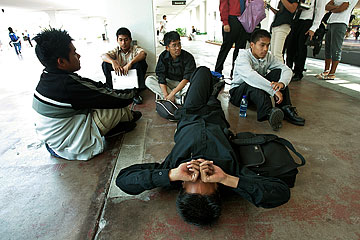
DENNIS ODA / DODA@STARBULLETIN.COM
Science projects of some 453 students * are on display at the Blaisdell Exhibition Hall. Devin Chong from Kealakehe Intermediate School shows his ROV (Remotely Operated Vehicle), which can operate underwater. CLICK FOR LARGE
|
|
Science fair wizards enlighten and amuse
Students investigate intriguing dilemmas
Carolynn Kitamura always wondered if the saying was true that dogs are cleaner than people. After extensive research, the Kamehameha Schools sophomore has an answer.
"Yes, humans are dirtier than dogs -- they have more bacteria," said Kitamura, one of 453 students from 76 public and private schools participating in the 50th Hawaii State Science and Engineering Fair.
She studied 17 dogs of different breeds and "got a big shock" when she compared some dogs with their owners. The owners had almost twice as much bacteria as their dogs, she said.

DENNIS ODA / DODA@STARBULLETIN.COM
Enjoying a break yesterday were Baldwin High students Chloe Edinger, left, Megham Luther, Nikki Biskis, Robert Epstein, Kevin Kim and Courtney Miyamoto. CLICK FOR LARGE
|
|
Another surprise: Outdoor dogs have less bacteria than indoor dogs, she said.
The fair opened with a ceremony Monday night at the Neal Blaisdell Center exhibition hall and ends today amid excitement over the talented young scientists and concern about future science fairs.
The Hawaii Academy of Science is seeking a two-year, $500,000 grant from the Legislature to sustain the annual event until it can hold a fundraising campaign and establish an endowment. The academy lost funding allocated through the Department of Education and drained a rainy-day fund to put on the present fair.
"Efforts of parents, teachers, the educational system and academy have elevated this to a tremendous celebration of 50 years," said Celia Smith, University of Hawaii botany professor and academy president.
The $150,000 in scholarship money and company and agency awards being presented to winners today isn't enough to recognize all the talent, she said.

DENNIS ODA / DODA@STARBULLETIN.COM
Katie Stewart, left, and Emily Isham had fun playing yesterday inside a model of the space shuttle that is on display at the Science Fair. The 12-year-olds attend St. Anthony School in Kailua. CLICK FOR LARGE
|
|
The projects get more sophisticated every year, said Catherine Uyehara, Tripler Army Medical Center research director, who was a science fair winner 30 years ago from McKinley High School. She said the youths "are going to do tremendous things" and hopefully they will choose to stay in Hawaii.
Hawaii Pacific University Vice President John Fleckles, a celebrity judge, said he got a lot of practical tips from the projects. For example, he said, the best sunglasses to wear, the most effective soundproofing material, not to drink from a water bottle more than once without sterilizing it and that "dog kisses are not good for you."
Many projects tackled problems related to Hawaii's environment and economy, such as taro, the dam break on Kauai and the papaya industry, noted John Nichols of Henkels & McCoy a utility contractor. As one of the judges, he said, "I was fascinated with the quality and thought that went into the experiments ... There is a lot of hope for the future, absolutely."

DENNIS ODA / DODA@STARBULLETIN.COM
Mark Gano got a quick nap while fellow Waipahu High School students Roland Isatangan, Arbie Campuspos, Ryan Batangan and Kevin Acacio took a break. All five were up late preparing for the fair. CLICK FOR LARGE
|
|
State fair winners and those of the Kauai, Maui, Windward and Leeward District Fairs will receive all-expense-paid trips to represent Hawaii at the International Science and Engineering Fair in Albuquerque, N.M., May 13-19. Winners of the Hawaii Association of Independent Schools Science Fair also will attend the international fair. Twenty junior division winners also will participate in the Discovery Channel Young Scientist Challenge.
Projects ranged from those easily understood to mind-boggling.
Caroline Benson, a Mililani Middle School eighth-grader who plays bass and loves bugs, tested effects of classical, jazz, oriental and rock music, plus silence, on 60 crickets. Chirping was loudest with the rock music and frequencies were highest with classical, she said.
Mililani High School junior Philip Mocz's entry was among the most complicated: "Smoothed Particle Hydrodynamics Simulation of the Structure and Dynamics of Interstellar Cloud-Collision to Shed Light on the Origins of Star Formations."
A top winner in last year's fair (as well as his younger sister Lucia), Mocz summarized his project as "using physical laws to calculate what happens when two interstellar clouds collide."

